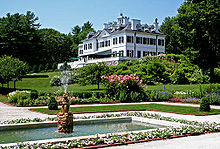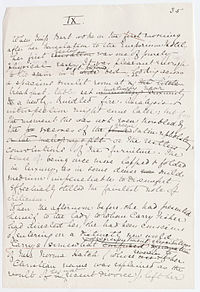Edith Wharton
From Wikipedia, the free encyclopedia
| Edith Wharton | |
|---|---|
 | |
| Born | January 24, 1862 New York City, New York |
| Died | August 11, 1937 (aged 75) Saint-Brice-sous-Forêt, France |
| Occupation | Novelist, short story writer, designer |
| Spouse(s) | Edward Wharton (1885–1913) |
Edith Wharton (/ ˈiːdɪθ ˈwɔːrtən/; born Edith Newbold Jones, January 24, 1862 – August 11, 1937) was a Pulitzer Prize-winning American novelist, short story writer, and designer.
Contents[hide] |
[edit]Biography
[edit]Early life and marriage
Wharton was born to George Frederic Jones and Lucretia Stevens Rhinelander in New York City. She had two brothers, Frederic Rhinelander and Henry Edward. The saying "Keeping up with the Joneses" is said to refer to her father's family.[1] She was also related to the Rensselaer family, the most prestigious of the old patroon families. She had a lifelong friendship with her Rhinelander niece, landscape architect Beatrix Farrand of Reef Point in Bar Harbor, Maine, and often traveled with Henry James in Europe. Wharton combined her insider's view of America's privileged classes with a brilliant, natural wit to write humorous, incisive novels and short stories of social and psychological insight. She was well acquainted with many of her era's other literary and public figures, including Theodore Roosevelt.
In 1885, at 23 years of age, she married Edward (Teddy) Robbins Wharton, who was 12 years older. From a well-established Boston family, he was a sportsman and gentleman of the same social class and shared her love of travel. From the late 1880s until 1902, he suffered acute depression, and the couple ceased their extensive travel.[2] At that time his depression manifested as a more serious disorder, after which they lived almost exclusively at The Mount, their estate designed by Edith Wharton. In 1908 her husband's mental state was determined to be incurable. She divorced him in 1913.[2] Around the same time, Edith was overcome with the harsh criticisms leveled by the naturalist writers. Later in 1908 she began an affair with Morton Fullerton, a journalist for The Times, in whom she found an intellectual partner.[3]
In addition to novels, Wharton wrote at least 85 short stories. She was also a garden designer, interior designer, and taste-maker of her time. She wrote several design books, including her first published work, The Decoration of Houses of 1897, co-authored by Ogden Codman. Another is the generously illustrated Italian Villas and Their Gardens of 1904.
[edit]Travels
In 1902 she built The Mount, her estate in Lenox, Massachusetts, which survives today as an example of her design principles. There, Edith Wharton wrote several of her novels, including The House of Mirth (1905), the first of many chronicles of the nature of old New York, and entertained the cream of American literary society, including her close friend, the novelist Henry James. Although she spent many months traveling in Europe nearly every year, The Mount was her primary residence until 1911. When living there and when traveling abroad, Wharton was usually driven to appointments by her longtime chauffeur and friend Charles Cook, a native of nearby South Lee, Massachusetts.[4][5] When her marriage deteriorated, however, she decided to move permanently to France, living initially at 58 Rue de Varenne, Paris, in an apartment that belonged to George Washington Vanderbilt II.
Helped by her influential connections to the French government, primarily through Walter Berry (then president of the American Chamber of Commerce in Paris), she was one of the few foreigners in France allowed to travel to the front lines during the First World War. Wharton described those trips in the series of articles Fighting France: From Dunkerque to Belfort.
Throughout the war she worked tirelessly in charitable efforts for refugees and, in 1916 was named a Chevalier of the Legion of Honour in recognition of her commitment to the displaced. The scope of her relief work included setting up workrooms for unemployed Frenchwomen, organizing concerts to provide work for musicians, opening tuberculosis hospitals and founding the American Hostels for Belgian refugees. In 1916 Wharton edited The Book of the Homeless, composed of writings, art, erotica and musical scores by almost every major contemporary European artist. When World War I ended in 1918 she abandoned her fashionable urban address for the delights of the country at the Pavillon Colombe in nearby Saint-Brice-sous-Forêt.
Wharton was a committed supporter of French imperialism, describing herself as a "rabid imperialist", and the war solidified her political conservatism.[6] After World War I, she travelled to Morocco as the guest of the resident general, Gen. Hubert Lyautey and wrote a book In Morocco, about her experiences. Wharton's writing on her Moroccan travels is full of praise for the French administration and for Lyautey and his wife in particular.
After the war she divided her time between Paris and Hyères, Provence, where she finished The Age of Innocence in 1920.
In 1927 she purchased a villa, Castel Sainte-Claire, on the site of a 17th-century convent, in the hills above Hyères in Provence, where she lived during the winters and springs. She called the villa "Sainte-Claire du Chateau" and filled the garden with cacti and subtropical plants. She returned to the U.S. only once after the war, to receive an honorary doctorate degree from Yale University in 1923.
[edit]Later years
The Age of Innocence (1920) won the 1921 Pulitzer Prize for literature,[7] making Wharton the first woman to win the award.
Wharton was friend and confidante to many gifted intellectuals of her time: Henry James, Sinclair Lewis, Jean Cocteau and André Gide were all guests of hers at one time or another. Theodore Roosevelt, Bernard Berenson, and Kenneth Clark were valued friends as well. But her meeting with F. Scott Fitzgerald is described by the editors of her letters as "one of the better known failed encounters in the American literary annals." She spoke fluent French (as well as several other languages), and many of her books were published in both French and English.
In 1934 Wharton's autobiography A Backward Glance was published. In the view of Judith E. Funston, writing on Edith Wharton in American National Biography, "What is most notable aboutA Backward Glance, however, is what it does not tell: her criticism of Lucretia Jones [her mother], her difficulties with Teddy, and her affair with Morton Fullerton, which did not come to light until her papers, deposited in Yale's Beinecke Rare Book Room and Manuscript Library, were opened in 1968."[8]
[edit]Death
Edith Wharton died of a stroke in 1937 at the domaine Le Pavillon Colombe, her 18th-century house on Rue de Montmorency in Saint-Brice-sous-Forêt. The street is today called rue Edith Wharton.[9][10] She is buried in the American Cemetery in Versailles, France.[2]
[edit]Writing style
Many of Wharton's novels are characterized by a subtle use of dramatic irony. Having grown up in upper-class pre-World War I society, Wharton became one of its most astute critics, in such works as The House of Mirth and The Age of Innocence.
In addition to writing several respected novels, Wharton produced a wealth of short stories and is particularly well regarded for her ghost stories.




No comments:
Post a Comment